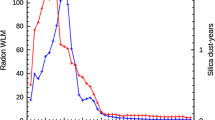Abstract
Objective
To evaluate the magnitude and temporal pattern of lung cancer risk following exposure to chrysotile asbestos.
Methods
I analyzed data on lung cancer mortality in a cohort of asbestos textile workers who were exposed to almost pure chrysotile. Employment history and industrial hygiene data were used to derive asbestos exposure estimates. These data were analyzed within the framework of the two-stage clonal expansion (TSCE) model and the Cox proportional hazards model.
Results
Under the TSCE model, the association between chrysotile asbestos and lung cancer mortality was primarily due to an exposure-induced increase in the proliferation of initiated cells. In a setting of protracted exposure to chrysotile asbestos, this model implies that the estimated hazard ratio was at its maximum between ages 40 and 65 years. Cox regression analyses support these conclusions; the estimated excess relative risk per fiber-year/ml was 0.053 (95% CI: 0.023, 0.124) at ages <65 years, while there was minimal evidence of association at older attained ages.
Conclusions
The TSCE model fits these data well, accommodating the observed departure from the proportional hazards assumption. These analyses suggest that the effect of chrysotile asbestos exposure on lung cancer risk varies with attained age.


Similar content being viewed by others
References
World Health Organization (2006) Elimination of asbestos-related diseases. World Health Organization, Geneva September, 2006
Dement JM, Harris RL Jr, Symons MJ, Shy CM (1983) Exposures and mortality among chrysotile asbestos workers. Part I. Exposure estimates. Am J Ind Med 4(3):399–419. doi:10.1002/ajim.4700040303
Hein MJ, Stayner LT, Lehman E, Dement JM (2007) Follow-up study of chrysotile textile workers: cohort mortality and exposure–response. Occup Environ Med 64(9):616–625. doi:10.1136/oem.2006.031005
Stayner L, Smith R, Bailer J, Gilbert S, Steenland K, Dement J et al (1997) Exposure–response analysis of risk of respiratory disease associated with occupational exposure to chrysotile asbestos. Occup Environ Med 54(9):646–652
Dement JM, Brown DP, Okun A (1994) Follow-up study of chrysotile asbestos textile workers: cohort mortality and case-control analyses. Am J Ind Med 26(4):431–447. doi:10.1002/ajim.4700260402
Thomas DC (1988) Models for exposure-time-response relationships with applications to cancer epidemiology. Annu Rev Public Health 9:451–482. doi:10.1146/annurev.pu.09.050188.002315
Moolgavkar SH (1986) Carcinogenesis modeling: from molecular biology to epidemiology. Annu Rev Public Health 7:151–169. doi:10.1146/annurev.pu.07.050186.001055
Heidenreich WF, Luebeck EG, Moolgavkar SH (1997) Some properties of the hazard function of the two-mutation clonal expansion model. Risk Anal 17(3):391–399. doi:10.1111/j.1539-6924.1997.tb00878.x
SAS Institute Inc (2007) SAS OnlineDoc® 9.2. SAS Institute Inc., Cary, NC
Preston DL, Lubin JH, Pierce DA, McConney ME (1993) Epicure: user’s guide. Hirosoft International Corporation, Seattle, WA
Richardson DB, Wing S (1998) Methods for investigating age differences in the effects of prolonged exposures. Am J Ind Med 33(2):123–130. doi:10.1002/(SICI)1097-0274(199802)33:2<123::AID-AJIM4>3.0.CO;2-Z
Pearce N (1988) Multistage modelling of lung cancer mortality in asbestos textile workers. Int J Epidemiol 17:747–752. doi:10.1093/ije/17.4.747
Peto J, Seidman H, Selikoff IJ (1982) Mesothelioma mortality in asbestos workers: implications for models of carcinogenesis and risk assessment. Br J Cancer 45(1):124–135
Thomas DC (1983) Statistical methods for analyzing effects of temporal patterns of exposure on cancer risks. Scand J Work Environ Health 9(4):353–366
Siemiatycki J, Wacholder S, Dewar R, Wald L, Begin D, Richardson L et al (1988) Smoking and degree of occupational exposure: are internal analyses in cohort studies likely to be confounded by smoking status? Am J Ind Med 13(1):59–69. doi:10.1002/ajim.4700130105
Axelson O, Steenland K (1988) Indirect methods of assessing the effects of tobacco use in occupational studies. Am J Ind Med 13(1):105–118. doi:10.1002/ajim.4700130107
Thomas DC, Whittemore AS (1988) Methods for testing interactions, with applications to occupational exposures, smoking, and lung cancer. Am J Ind Med 13(1):131–147. doi:10.1002/ajim.4700130109
Checkoway H, Pearce N, Kriebel D (2004) Research methods in occupational epidemiology, 2nd edn. Oxford University Press, Oxford
Acknowledgments
This project was supported by grant K01-OH008635 from the National Institute for Occupational Safety and Health of the Centers for Disease Control and Prevention.
Author information
Authors and Affiliations
Corresponding author
Rights and permissions
About this article
Cite this article
Richardson, D.B. Lung cancer in chrysotile asbestos workers: analyses based on the two-stage clonal expansion model. Cancer Causes Control 20, 917–923 (2009). https://doi.org/10.1007/s10552-009-9297-z
Received:
Accepted:
Published:
Issue Date:
DOI: https://doi.org/10.1007/s10552-009-9297-z




